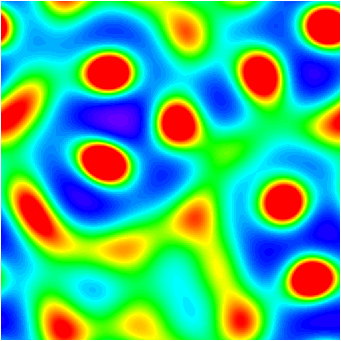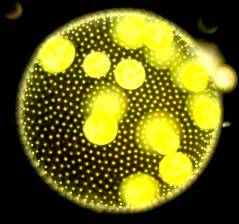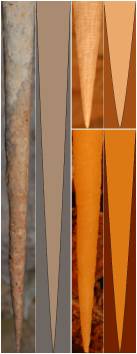 My
current
research involves the modeling of certain types of human activity that
exhibit regular spatio- and/or temporal patterns. As a case
study, we have generally focused on various types of criminal behavior,
since there are clear patterns in this activity and we have access to
relatively large amounts of data. A large portion of this work
aims to model the formation and dynamics of crime "hotspots" -
spatio-temporal regions of increased criminal activity. Working with
data provided by the Los Angeles and Long
Beach police departments, we have developed methods of measuring the
repeat and near-repeat criminal events that are the hallmarks of
hotspot
formation. We have also constructed a family of discrete
models that allow for such patterns to develop from natural criminal
behavior, and have derived continuum approximations of these discrete
models. Some output from one of many simulations (right) illustrates
this finding, with "hot" areas in red and "cold" areas in purple.
My
current
research involves the modeling of certain types of human activity that
exhibit regular spatio- and/or temporal patterns. As a case
study, we have generally focused on various types of criminal behavior,
since there are clear patterns in this activity and we have access to
relatively large amounts of data. A large portion of this work
aims to model the formation and dynamics of crime "hotspots" -
spatio-temporal regions of increased criminal activity. Working with
data provided by the Los Angeles and Long
Beach police departments, we have developed methods of measuring the
repeat and near-repeat criminal events that are the hallmarks of
hotspot
formation. We have also constructed a family of discrete
models that allow for such patterns to develop from natural criminal
behavior, and have derived continuum approximations of these discrete
models. Some output from one of many simulations (right) illustrates
this finding, with "hot" areas in red and "cold" areas in purple.
In addition to the work on crime hotspots, this overarching project has also included: more accurate predictions of when and where crimes will occur, based on self-exciting point process models borrowed from seismology; the study of gang territoriality, modeled via diffusive Lotka-Volterra equations; gang retaliatory violence, and how the police may be able to solve such crimes using constrained optimization; the evolution of gang rivalry networks in the presence of retaliation and third-party effects; game theoretic models for the levels of both crime and cooperation with the authorities in society; and new methods for finding the "anchor points" of criminals given the locations of crimes they committed, based on models inspired by animal foraging. Please see my publications page for prints of all these works and more.
This work is being done in collaboration with Jeff Brantingham, Andrea Bertozzi, Lincoln Chayes, George Tita, George Mohler, Maria D'Orsogna, and others.
The role of advection in the evolution of aquatic microorganisms
 For
many species of aquatic
microorganisms (such as Volvox,
pictured to the left), diffusion alone cannot supply nutrition at a
rate high enough to keep the organism alive if the size of the organism
exceeds a critical value. These organisms can get around this
evolutionary bottleneck by using flagella to swim in their aqueous
surroundings, thereby bringing advection into the picture.
This advection effectively "stirs" the solution, greatly
increasing the nutrient uptake rate, which allows the organisms to
continue to evolve to ever greater sizes. In addition, for
the specific example of Volvox,
this adaptation necessitates the transition from species with only one
type of cell to those in which cell specialization exists.
Our work in this area models these various processes for the
many species of Volvox.
We use experimental measurements to validate our models and
find that our predicted bottleneck radius, at which cell specialization
must occur, is very close to the actual size in which this adaptation
is observed.
For
many species of aquatic
microorganisms (such as Volvox,
pictured to the left), diffusion alone cannot supply nutrition at a
rate high enough to keep the organism alive if the size of the organism
exceeds a critical value. These organisms can get around this
evolutionary bottleneck by using flagella to swim in their aqueous
surroundings, thereby bringing advection into the picture.
This advection effectively "stirs" the solution, greatly
increasing the nutrient uptake rate, which allows the organisms to
continue to evolve to ever greater sizes. In addition, for
the specific example of Volvox,
this adaptation necessitates the transition from species with only one
type of cell to those in which cell specialization exists.
Our work in this area models these various processes for the
many species of Volvox.
We use experimental measurements to validate our models and
find that our predicted bottleneck radius, at which cell specialization
must occur, is very close to the actual size in which this adaptation
is observed.This work was a part of my PhD thesis and was done in collaboration with Cristian Solari, Sujoy Ganguly, Thomas Powers, John Kessler, and Raymond Goldstein.
Growth and formation of stalactites and icicles
 Though
the general processes underlying the formation of stalactites and
icicles have long been known, it was unclear how these processes
eventually led to the iconic carrot-like shape often associated with
these objects. This research project modeled the growth of
both
stalactites and icicles as free-boundary problems, arriving at growth
laws for each of these objects. Interestingly, these growth
laws
are scale invariant, implicating that there is in fact a single
platonic ideal shape for both stalactites (picture at right)
and
icicles. Even more interestingly, the mathematical form for
the
ideal stalactite is the same as that for the ideal icicle far from the
tip, even though the growth processes underlying these two structures
are vastly different.
Though
the general processes underlying the formation of stalactites and
icicles have long been known, it was unclear how these processes
eventually led to the iconic carrot-like shape often associated with
these objects. This research project modeled the growth of
both
stalactites and icicles as free-boundary problems, arriving at growth
laws for each of these objects. Interestingly, these growth
laws
are scale invariant, implicating that there is in fact a single
platonic ideal shape for both stalactites (picture at right)
and
icicles. Even more interestingly, the mathematical form for
the
ideal stalactite is the same as that for the ideal icicle far from the
tip, even though the growth processes underlying these two structures
are vastly different.This work was a part of my PhD thesis and was done in collaboration with Jim Baygents, Warren Beck, David Stone, Rick Toomey, and Raymond Goldstein.
